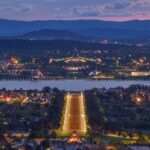Overview
The Australian Capital Territory (ACT) may be small in size, but it’s big on culture, history, and natural beauty. Home to Canberra — Australia’s purpose-built capital city — the ACT is where politics, art, science, and the great outdoors come together. Surrounded by national parks and full of galleries, museums, and gardens, it’s a compact yet enriching destination.
- Capital: Canberra (also the national capital)
- Population: ~460,000 (2024 est.)
- Time Zone: Australian Eastern Standard Time (AEST) UTC+10 / AEDT (DST)
- Climate: Continental climate with four distinct seasons – hot summers, cold winters, and colorful autumns
Top Destinations in the ACT
Canberra
Australia’s capital is filled with cultural institutions, modern architecture, beautiful parks, and political landmarks.
Tidbinbilla Nature Reserve
A haven for bushwalking, wildlife spotting, and learning about Indigenous culture.
Namadgi National Park
A mountainous park in the northern tip of the Australian Alps, ideal for hiking and nature escapes.
Must-See Attractions
- Parliament House – Take a tour, watch live debates, or simply admire the striking architecture
- Australian War Memorial – A powerful and moving tribute to Australia’s military history
- National Gallery of Australia – Home to an extensive collection of Australian, Aboriginal, and international art
- Questacon – The National Science and Technology Centre – A family-friendly interactive science museum
- Lake Burley Griffin – Ideal for cycling, kayaking, or relaxing along the foreshore
Things to Do
- Cycle around Lake Burley Griffin or rent a paddle boat
- Explore the National Museum of Australia and learn about Aussie history and identity
- Visit Floriade in spring — the Southern Hemisphere’s largest flower festival
- Wander the Australian National Botanic Gardens
- Enjoy Canberra’s thriving food and wine scene in the city or surrounding wine regions
Getting There & Around
Airport
- Canberra Airport (CBR)
Transport
- Local buses and light rail via Transport Canberra
- Cycling-friendly with well-connected bike paths
- Compact and easy to drive around — car hire available for exploring nearby parks
Best Time to Visit
- Spring (Sep–Nov): Ideal weather and Floriade festival
- Autumn (Mar–May): Stunning autumn leaves across the city
- Winter (Jun–Aug): Cold but great for indoor museums and mountain views
- Summer (Dec–Feb): Warm days perfect for lake activities and outdoor events
Local Food & Culture
- Cuisine: A growing foodie destination with modern Australian dining, international cuisines, and farmers markets
- Wineries: ACT wine region (including Murrumbateman) is known for cool-climate wines
- Events: Floriade, Enlighten Festival, National Multicultural Festival, Canberra Balloon Spectacular
- Aboriginal culture: Learn about the Ngunnawal people through local art, signage, and guided walks
Souvenirs from the ACT
- Indigenous art from local galleries
- Handmade gifts from Old Bus Depot Markets
- Australian War Memorial merchandise
- Wine, gin, and produce from Canberra’s wine region
Fun Facts
- Canberra was selected as Australia’s capital in 1908 as a compromise between Sydney and Melbourne
- The city was designed by American architects Walter Burley Griffin and Marion Mahony Griffin
- Nearly 70% of the ACT is protected nature reserve or national park
- Canberra has one of the highest rates of bicycle commuting in Australia
Suggested Itineraries
3-Day Canberra Cultural Escape
- Day 1: Parliament House + Australian War Memorial
- Day 2: National Gallery + Questacon + sunset at Mount Ainslie
- Day 3: Lake Burley Griffin + Botanic Gardens + local wineries
2-Day Nature & History Combo
- Day 1: National Museum + Tidbinbilla walk + Aboriginal culture tour
- Day 2: Namadgi National Park hike + rural villages + return to city

